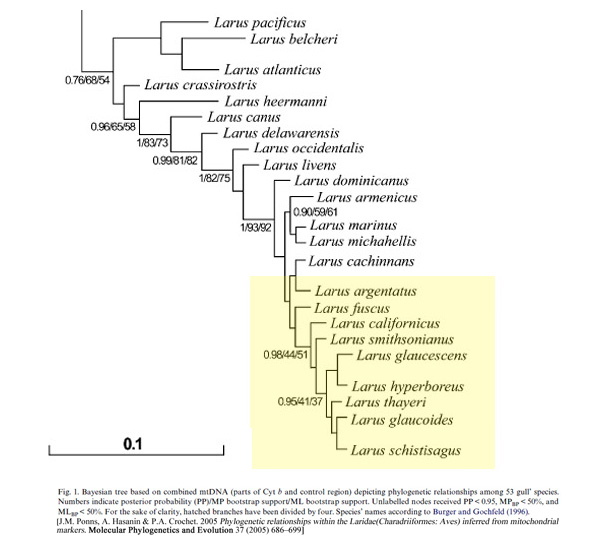It's coming up on that time of year...
Summer time is approaching and all the lingering sub-adult gulls are beginning to molt. This is the time of year when even the most dependable of field marks will fail us for some individuals.
Feathers wear out. Most birds replace their flight feathers once a year and their body feathers at least once (in many species twice) in a year. In gulls however, birds hatched last year actually end up keeping their feathers for up to a couple months longer than a calendar year. Most immature gulls we see now fledged at the end of June last year, but their molt cycle usually begins in July and August. The previous year’s juveniles always show more feather wear by midsummer than older birds.
Gulls do not replace all their flight feathers at once. They molt sequentially, beginning with the innermost primaries.
The process of replacing all the flight feathers takes weeks and while molt is going on, some birds can look pretty sad. The time lag between those first new feathers and the last ones is significant enough to show as uneven wear of the flight feathers of older birds when compared to fresh juveniles which grew in all their flight feathers at once. A juvenile’s feathers wear out all at once, too, and that’s partly why some look so sad and ratty this time of year.
So, why don’t all these young molting gulls look equally awful?
There are many things that contribute to feather wear: sun, dirt, bacteria, avian parasites, not to mention day to day use. But the single most important mitigating factor in comparative feather longevity is the presence or absence of feather pigments collectively known as melanins. There are two general classes of melanin. Eumelanins which produce blacks and grays and Phaeomelanins which produce browns and reddish colors. Eumelanins add to the structural integrity of flight feather which is most probably why large, flight dependent birds routinely have black wingtips. Melanins may also promote drying of feathers by absorbing radiant heat and there is some evidence that melanin may also inhibit bacterial degradation of feathers.
If we compare the wear patterns of feathers molted from older birds to those of the younger ratty looking birds the effects of melanin can be seen.

Note, for example, only the white primary tips have worn away in the feathers (right side) of older birds while the feathers from younger birds (left side) are worn back to sharp, frayed points.
So, the bottom line is that gull identification can be harder than usual in the molting season and even the hardcore lariphiles may get stumped by some of the more scrappy-looking individuals. There is never any shame in defaulting to gull sp.
References
Gill, F.B. 1989. Ornithology. W.H. Freeman and Co., New York.
Howell, S.N.G. and J. Dunn. 2007. Gulls of the Americas. Houghton-MifflinCo., Boston.
Howell, S.N.G. 2010. Molt in North American Birds. Houghton-MifflinCo., Boston.
Pyle, P. 2008. Identification Guide to North American Birds, Part II. Slate Creek Press, Point Reyes Station, CA.
Winkler, David W. 1996. California Gull (Larus californicus), The Birds of North America Online (A. Poole, Ed.). Ithaca: Cornell Lab of Ornithology; Retrieved from the Birds of North America Online: http://bna.birds.cornell.edu/bna/species/259
Melanin in Wikipedia http://en.wikipedia.org/wiki/Melanin
Modified from an article written by Mike Patterson originally posted at: http://www.surfbirds.com/community-blogs/northcoastdiaries/?p=1575









